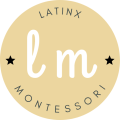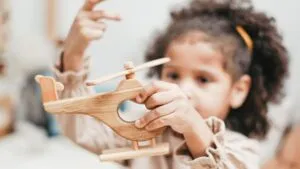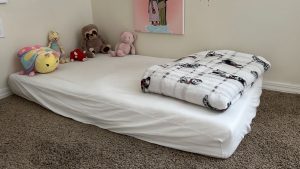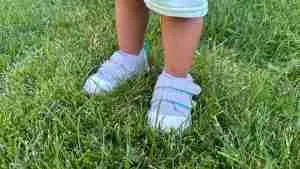
Benefits of Play Schemas in Child Development
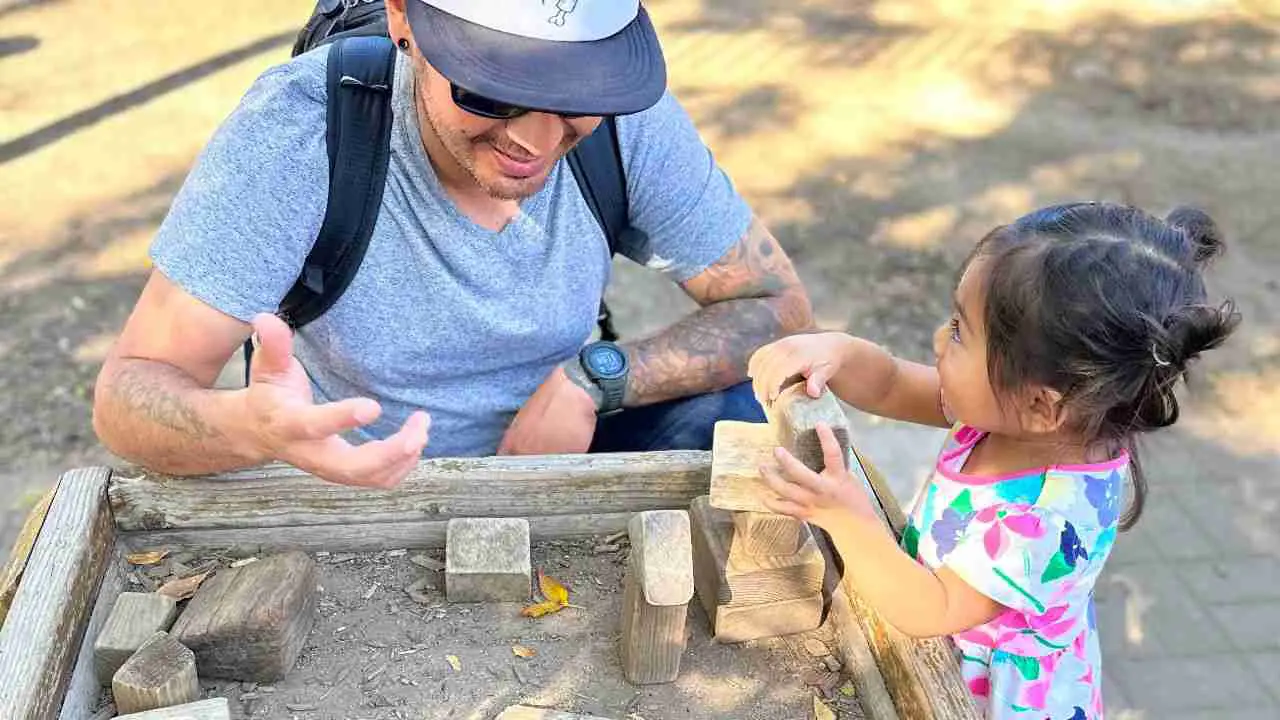
*Disclosure: I only recommend products I would use myself and all opinions expressed here are our own. This post may contain affiliate links that at no additional cost to you, I may earn a small commission. Thank you for your support!
Share this post
What are play schemas?
A play schema is a set of instructions that children use to learn about their environment and is the key to unlocking your child’s imagination and helping them grow.
Even we, adults, use schemas all the time to complete a task like grabbing a spoon, scooping food into the spoon, and bringing food into our mouths.
An infant does not know what to do with the spoon. Babies don’t know that a spoon is for eating, so we need to provide these instructions to them. This is how they build schemas.
As a parent, you must understand play schemas because they will help you connect with your child and support their learning journey.
One way to do so is by providing developmentally appropriate toys and activities that nurture their interests and creativity.
But don’t feel overwhelmed. I will give you real-world examples of the 9 play schemas that are important in child development so you can apply them at home.
Quick summary of play schemas
There are 9 play schemas that help children explore their world, and as a Montessori guide, I’ve had the privilege of witnessing their magic firsthand with my child:
Transporting schema: Children move objects from one place to another, like transporting toys from room to room.
Connecting schema: Kids link and join objects together like train tracks.
Orientation schema: Children look at objects from different viewpoints like upside down or sideways.
Rotational schema: Children spin and turn, or create circular motions with objects.
Trajectory schema: Children are fascinated by the path of objects through the air like throwing a ball.
Enveloping schema: Kids hide and cover objects or play hide and seek.
Positioning schema: Children arrange and organize objects in specific ways to create patterns.
Transforming schema: Kids change the shape of objects like using playdough to make figures.
- Enclosing schema: Children create enclosures or boundaries using objects, like building forts or walls.
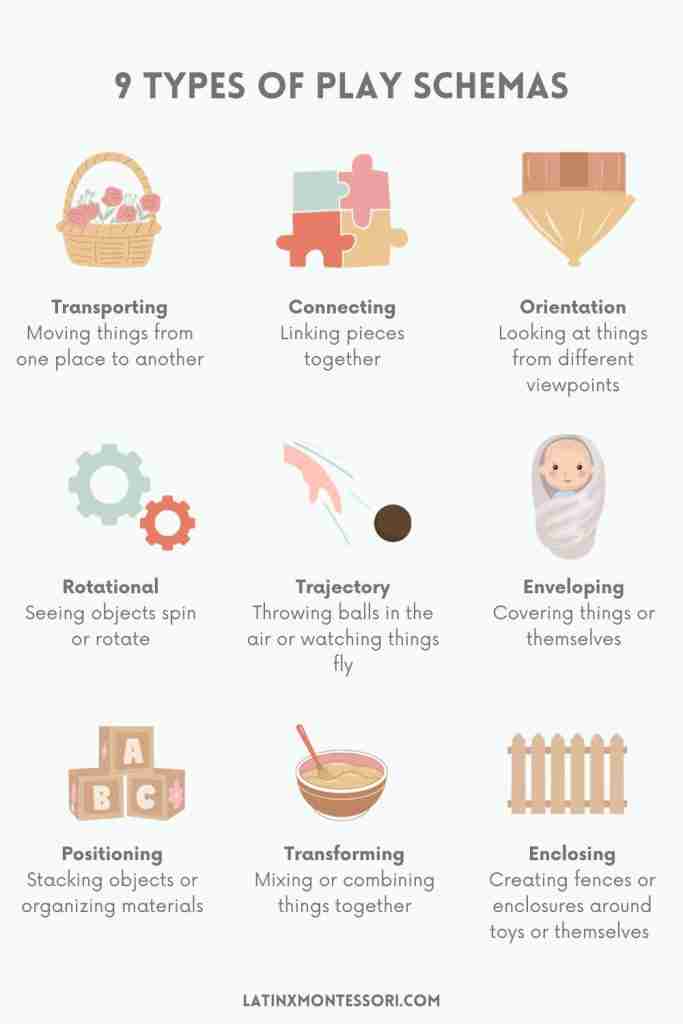
Let’s cover each schema in detail and I will give you some examples of how you can apply it in your Montessori home.
9 play schemas and examples of each
1. Transporting schema
Children enjoy moving objects from one place to another like carrying their toys around, pushing toy cars, or arranging objects in specific locations.
What your child is learning: This schema helps your child understand spatial relationships, develop motor skills, and learn about cause and effect.
Real-life example: My daughter likes to set up the table before we eat. She carries plates, cups, and utensils to her weaning table.
This is also a great practical life activity to encourage independence and order.
How you can use it: Encourage your child to carry objects, place toys in a basket and transport them to another place, or help organize their room.
Toy suggestions: Pull-along toys, toy wagons, or baskets for carrying various items.
2. Connecting schema
Kids love to join things together like train tracks or puzzles. They might build intricate structures with building blocks, create chains, or link objects in creative ways.
What your child is learning: This schema promotes spatial awareness, fine motor skills, and problem-solving abilities.
Real-life example: We have a small set of train tracks that engage our daughter’s problem-solving skills.
She is learning that not every train track fits nicely and she needs to turn each track so they snap together.
How you can use it: Provide various building materials and encourage them to make unique structures, bridges, or patterns.
Toy suggestions: Building blocks, wooden train sets, or magnetic construction sets.
3. Orientation schema
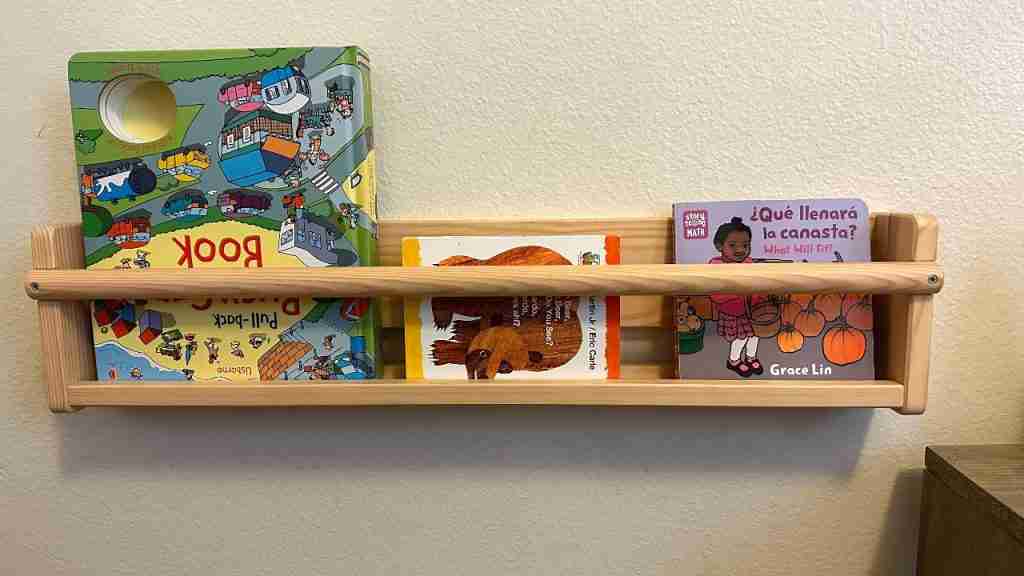
Children arrange objects in specific ways, align toys, or pay great attention to the positioning of items in their room.
What your child is learning: This schema fosters spatial awareness, order, and great attention to detail.
Real-life example: Our daughter has a small bookshelf in her room and one time we placed a book upside down and she walked to the bookshelf to fix it.
How you can use it: You can help your child organize their toy or book shelf, place toys in a specific way, or invite them to rearrange their bedroom.
Toy suggestions: Sorting toys that challenge your child to categorize objects by size, shape, or color.
4. Rotational schema
Children like spinning objects, turning items, or creating circular movements. They also twirl around just for fun.
What your child is learning: This schema enhances fine motor skills, hand-eye coordination, and an understanding of concepts like speed and balance.
Real-life example: We built some of our daughter’s shelves and clothes rack and she helped us put bolts and screws to hold pieces together.
She saw how we were using the screwdriver to screw pieces of wood together and we let her try it on her own.
How you can use it: Simple activities you can do are dancing and twirling to their favorite song.
Toy suggestions: Marble run set.
5. Trajectory schema
Kids throw, launch, or drop items and watch how they move. It can be as simple as throwing a ball.
What your child is learning: This schema develops hand-eye coordination, spatial understanding, and cause and effect.
Real-life example: We like to play catch. Our daughter likes to throw the ball to us or straight up in the air.
When we go to the river or lake, she likes to throw rocks and we also show her how to skip rocks.
How you can use it: Offer opportunities for safe throwing, like playing catch, or launching toy airplanes for them to follow.
Toy suggestions: Balls for throwing and catching or frisbees.
6. Enveloping schema

Children cover, wrap, or enclose objects. They create cozy spaces for toys, wrap things in blankets, or hide items.
What your child is learning: This schema fosters creativity, organization, and the concept of containment.
Real-life example: My daughter has a Pikler triangle which is sometimes used as a tent. She places her blanket over the Pikler triangle to create a tent and we pretend we are camping.
She also likes to cover our dogs with a blanket because she thinks they are cold!
How you can use it: Encourage your child to build forts or tents with blankets or boxes.
Toy suggestions: Building fort kits, soft blankets, or play tents.
7. Positioning schema
Children arrange objects in specific ways. They love creating patterns, lines, or organized setups with their toys or materials.
What your child is learning: This schema promotes orderliness, spatial awareness, and organization.
Real-life example: Our daughter has a few sets of building blocks and uses them to create a road for her cars.
And since she is learning colors, we try to make color patterns just to make the road a bit more interesting.
How you can use it: You can teach your child how to pack away their toys or encourage them to sort objects by size, color, or shape.
Toy suggestions: Sorting toys or pattern-making materials.
8. Transforming schema
Children experiment with changing the shape or appearance of objects. They mold clay into various forms or reshape materials.
What your child is learning: This schema nurtures creativity, fine motor skills, and an understanding of material properties.
Real-life example: Sometimes our daughter helps us make pancakes. She mixes the pancake mix, water, and eggs to create a mixture.
When she gets home from school, we like to make juices by mixing greens and fruits. These are also simple practical life activities that are engaging and fun.
How you can use it: Making pancakes is a great example but you can also provide molding clay or learn how to make playdough together.
Toy suggestions: Playdough sets, modeling clay, or craft kits.
9. Enclosing schema
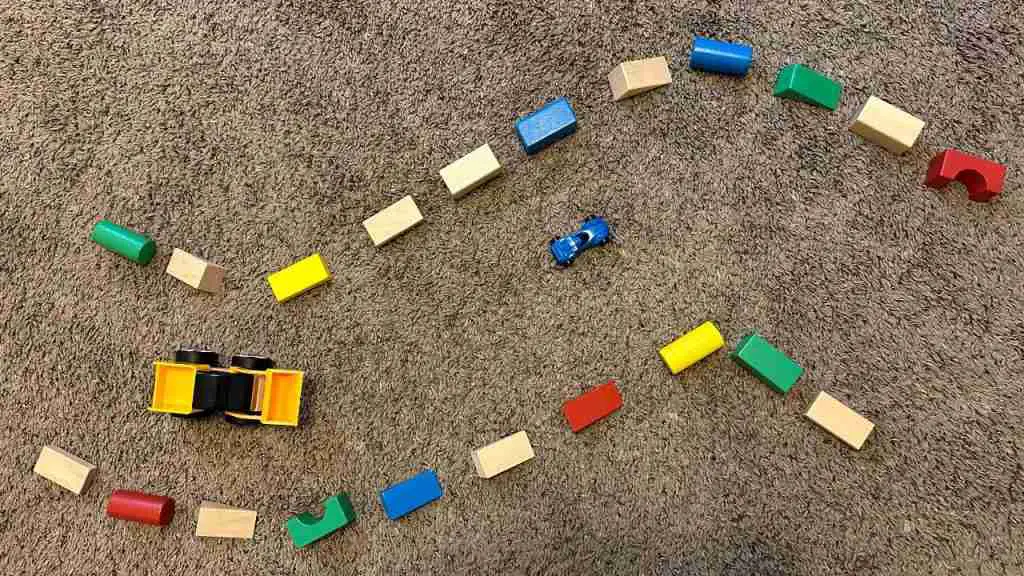
Children create enclosures or boundaries using objects. They construct walls for their toy animals or build fences.
What your child is learning: This schema enhances spatial awareness, creativity, and an understanding of containment.
Real-life example: We always get a good laugh when our daughter builds a small wall in front of our dog.
She uses anything she can like stuffed animals and toys or some of her building blocks.
How you can use it: Your child can use sticks to build fences for their toy animals, use boxes to build forts, or beach toys to build sandcastles.
Toy suggestions: Wooden blocks, toy animals, or building sets.
Quick history on schemas of play
Jean Piaget was a Swiss psychologist who is often referred to as the father of developmental psychology.
His work in the early 20th century fundamentally reshaped our understanding of child development.
Piaget believed that children actively construct their understanding of the world through exploration and play.
He observed that children don’t just play randomly. Instead, they engage in specific, repetitive patterns of play, which he called “schemas.”
These schemas are how children experiment with the world around them, form hypotheses, and test them out.
One of Piaget’s most significant contributions was his idea of “cognitive development stages.”
He proposed that children progress through distinct stages of development, each characterized by unique cognitive abilities and play preferences.
Piaget’s stages of play
Piaget’s stages of play include the sensorimotor stage (0-2 years), the preoperational stage (2-7 years), the concrete operational stage (7-11 years), and the formal operational stage (11 years and beyond).
In the sensorimotor stage, babies engage in simple sensorimotor play, like shaking a rattle or placing objects in their mouths.
In the preoperational stage, children explore play schemas that involve symbolic play, such as pretending a stick is a sword or a box is a spaceship.
In the concrete operational stage, a child may use their understanding of conservation, such as realizing that the amount of liquid in a tall, thin glass is the same as in a short, wide glass.
In the formal operational stage, a person might engage in abstract thinking, like solving complex algebraic equations, without the need for physical manipulatives.
As your child moves through these stages, their play schemas become more complex, reflecting their cognitive development.
Now you understand that play schemas aren’t just about fun and games, they are fundamental to your child’s cognitive growth.
You can support your child’s natural learning process just by recognizing and supporting these schemas.
How do play schemas align with Montessori?
Maria Montessori emphasized the importance of hands-on, experiential learning that empowers children to explore and discover the world for themselves.
Play schemas closely align with this philosophy because we let our children learn on their own with little to no interruption from us.
Montessori classrooms have materials and activities designed to encourage children’s natural curiosity and drive for exploration.
This closely mirrors the principles of play schemas, where children follow their inner motivations and interests to learn.
The Montessori approach also emphasizes the role of the prepared environment which is carefully arranged to stimulate a child’s intellectual, physical, and emotional development.
Play schemas at home
You can apply the same principles in your home so your child continues to build schemas through play.
Start by creating a Montessori-inspired space that mirrors the principles of preparedness and encourages self-directed exploration.
Offer open shelves with carefully selected toys and materials that align with your child’s emerging schemas to promote independence and learning.
I always advise parents to respect their children’s freedom to choose their play and adapt to their interests.
This encourages your child to learn at their own pace using toys or activities that are engaging and nurture their overall development.
What to do next?
Your child is constantly learning new things and making sense of the world. Play schemas are like the unique blueprints that children use in their playtime adventures.
Just like you learn how to complete a new task, your child is learning hundreds of new things simply by exploring on their own.
I encourage you to enroll in my online course, Benefits of Play so you learn how to nurture your child’s development through fun and engaging play activities.
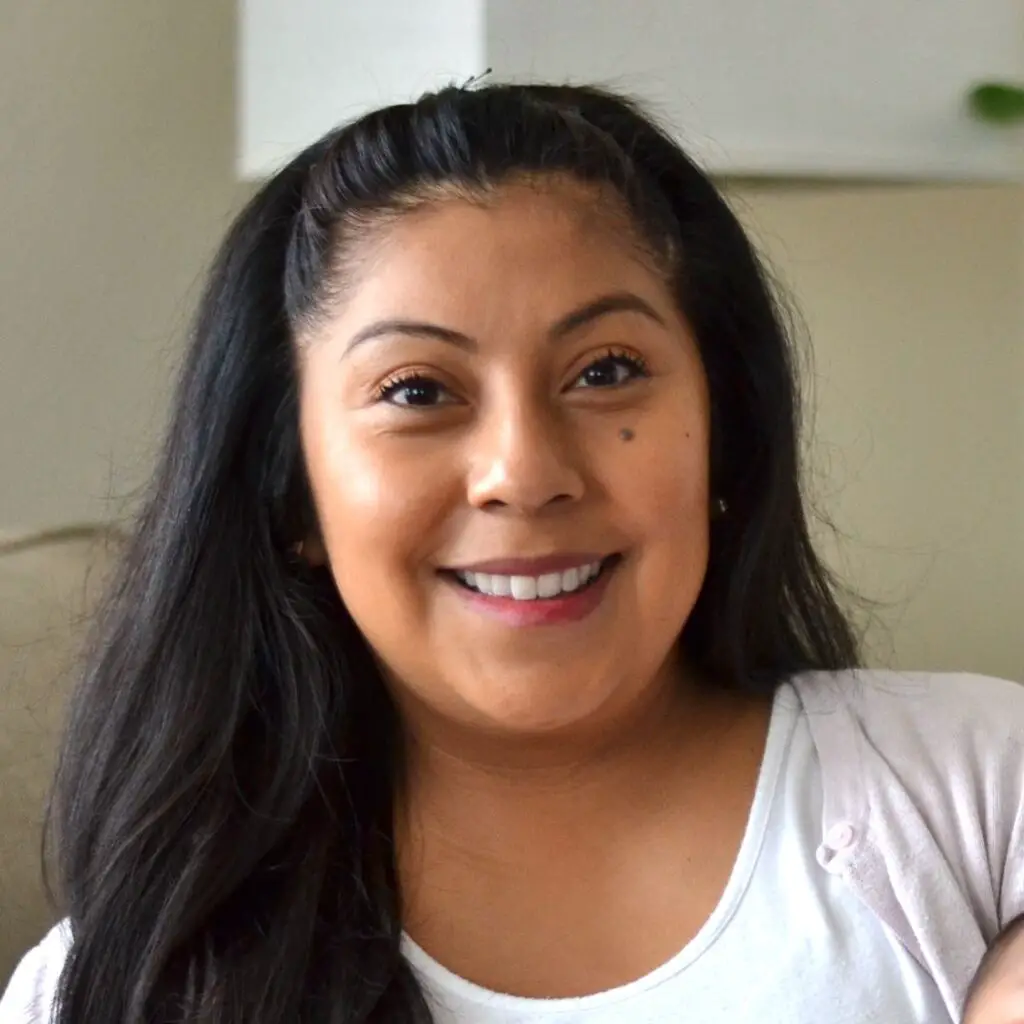
Hello, I am Leslie. I am on a mission to help you support the growth and development of your child. With the right tools and proper guidance, you can navigate parenthood with confidence and assertion! My goal is to equip you with knowledge to help you construct a strong foundation for your child’s life.
Suggested articles
You May Also Like
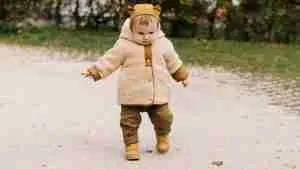
Should Babies Wear Shoes? 3 Life-Changing Things To Know
Should babies wear shoes? According to the American Academy of Pediatrics, babies should only wear shoes once they begin walking.

Will Ceiling Fan Make Newborn Sick? Things To Know
No, a ceiling fan will not make your newborn sick. In fact, it helps maintain a comfortable and cool environment and lowers the risk of SIDS because it improves air circulation.

What is Montessori Play? And why it works
Montessori play is a method that helps children learn practical life skills in a fun and engaging way. Activities are done because a child enjoys them, not to accomplish an end goal.
